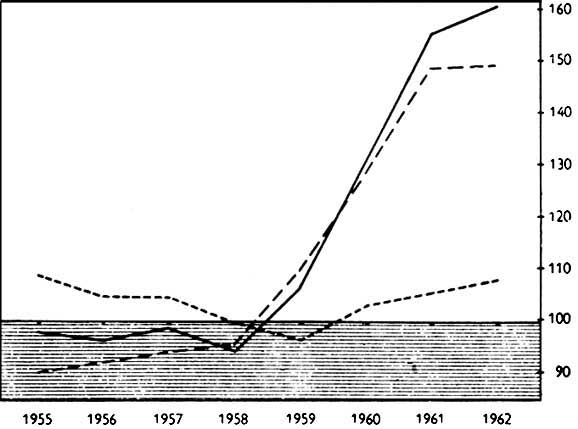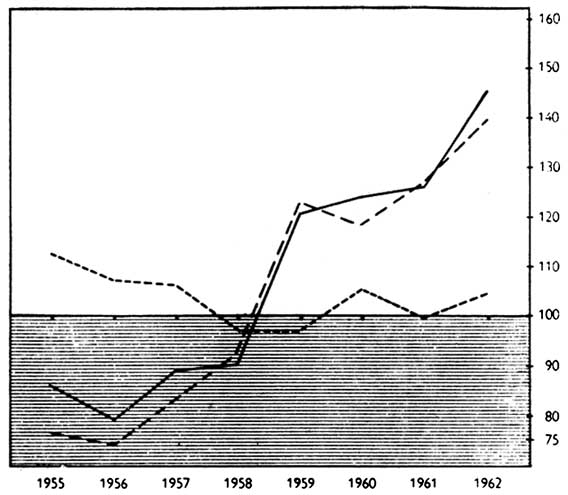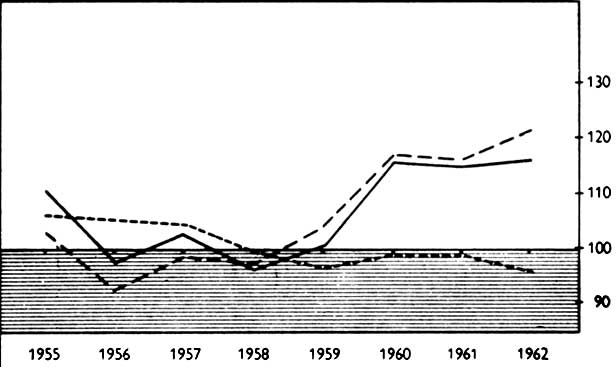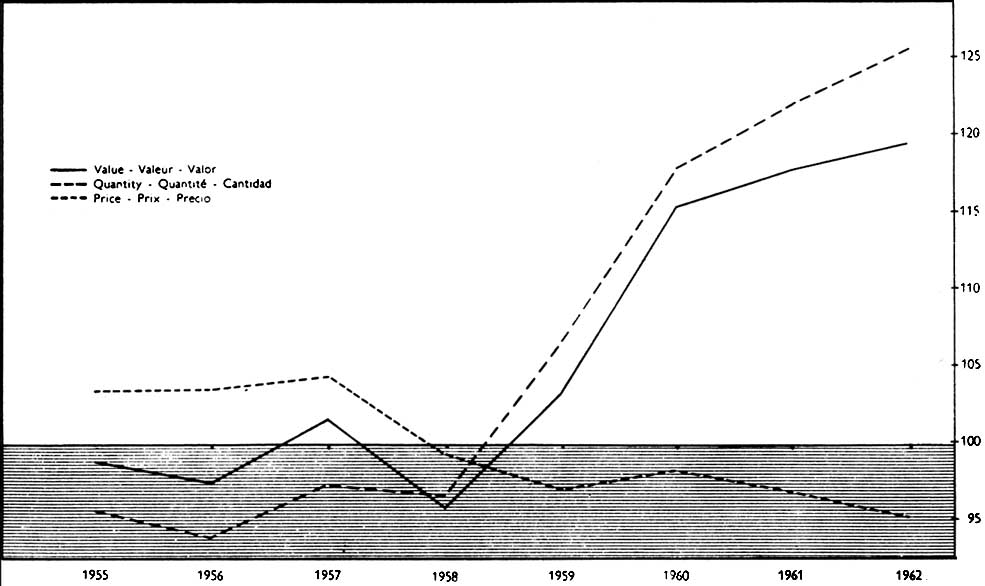Pulp and paper development in Africa and the Near East
FAO advisory committee on pulp and paper
Personnel news
The editorial in this issue comments on the Conference on Pulp and Paper Development in Africa and the Near East held at Cairo, United Arab Republic, from 8 to 20 March 1965.
Organized jointly by FAO, the United Nations Economic Commission for Africa (ECA) and the United Nations Bureau of Technical Assistance, for developing countries of the area, the conference was attended by representatives, consultants or observers from 41 countries: Algeria, Belgium, Burma, Cameroon, Canada, Cuba, Czechoslovakia, Denmark, Finland, France, Federal Republic of Germany, Greece, India, Iraq, Italy, Ivory Coast, Japan, Jordan, Kenya, Libya, Malawi, Mexico, Morocco, New Zealand, Nigeria, Norway, Philippines, Poland, Romania, Sweden, Switzerland, Tanzania, Tunisia, Uganda, United Arab Republic, United Kingdom, United States, U.S.S.R., Venezuela, Yugoslavia, and Zambia.
Husain Kamel, President of the Al Nasr Sugar and Pulp Company, Cairo, and a member of the FAO Advisory Committee on Pulp and Paper, was elected conference chairman, and M. Rukuba (Uganda) and C.F.A. Onochie (Nigeria) were elected vice-chairmen. The secretariat was headed by P. J. Vakomies, Chief Of FAO's Forest Industries Branch, and B. Nomvete, Head of ECA's Industry Division. Present were FAO's Regional Representative for the Near East (A. R. Sidky), FAO Assistant Director-General Egon Glesinger, Deputy Regional Representative for Africa (A. E. Chinbuah), and the Director and Deputy Director of FAO's Forestry and Forest Products Division.
The conference was the third in a series of such regional meetings arranged by FAO, the first two having been concerned with pulp and paper development in Latin America and in the Far East. The background was the FAO estimate that paper consumption in the region (as defined for the purposes of this conference) would rise from 1 million tons in 1960 to a requirement of 4 million tons in 1980. At the same time (1964) FAO had indicated to the United Nations Conference on Trade and Development that by 1975 Europe would probably need to import substantial additional quantities of pulp, and this might well come from those developing countries that could offer what was needed at a competitive price.
Over 80 papers prepared by the secretariat or contributed by specialists served as a basis for the conference discussions which were divided into seven main sections: past developments and future demand estimates; appraisal of the region's fibrous raw material supply; economic availability and technical suitability; appraisal of the region's other prerequisites for pulp and paper production; economic aspects of production; development prospects and investment needs; prospects for regional free trade in pulp and paper; and the integration of other forest industries with pulp and paper manufacture.
Discussion leaders appointed for these topics were A. Sundelin (Sweden), A. L. Poole (New Zealand), V. Podder (India), G. Chidester (United States), L. Thiesmeyer (Canada), B. Steenberg (Sweden), L. Kirves (Finland), and B. V. Fuller (United Kingdom).
The conference concluded that the fiber resources of the region, if developed, could satisfy both internal needs and part of the rapidly rising world demand. Natural forests cover about 680 million hectares, or about 22 percent of the region's total land area. More than 2 million hectares of plantations are established in the region and are already supporting a substantial pulp and paper industry. Further expansion is expected.
The use of mixed tropical hardwood for the production of pulp was discussed. Experience showed that the percentage of species unsuitable for pulping was low and that the best method of management seemed to be clear-felling and harvesting followed by plantation of selected species. A hypothetical case study showed that the cost of such wood delivered to the mill compared favorably with prevailing pulpwood prices in other parts of the world.
The conference gave attention to various nonwood raw materials, including bagasse, bamboo, esparto, papyrus, reeds, straw, and sisal. It was agreed that different types of bagasse pulp could be used in a wide range of papers, in some grades for 100 percent of the furnish.
A special working party was set up to consider the economic and technical aspects of producing newsprint from bagasse. This working party regarded it as important that developing countries with prospects of establishing newsprint production based on bagasse should have available to them both an affirmation of the technical feasibility of such production and a reasoned appreciation of the economic factors involved.
Since water is scarce in many parts of the region, much emphasis was given in discussions to minimum water requirements and to water recirculation problems.
FIGURE 1. - Removals, 1950 and 1963. Forests, 1958.
Indices of world exports of forest products (1957-1959 = 100).





NOTE: These two charts are taken from the FAO Yearbook of forest statistics 1964.
The conference recommended that FAO and ECA, in collaboration with other interested parties, should study the ways in which new mills could be financed and the financing guaranteed. The successful launching of a new pulp and paper enterprise requires not only raw materials, but also capital, technical and managerial skills, and assured markets.
At the sixth meeting of the FAO Advisory Committee on Pulp and Paper, held in Rome from 10 to 11 May 1965 under the chairmanship of R. M. Fowler, President of the Canadian Pulp and Paper Association, one of the chief matters of business was to discuss the findings of the Cairo Conference. The advisory committee concurred with the expectation that demand for paper and paperboard in Africa and the Near East would more than double by 1980, and noted that it seemed possible for new pulp and paper industries to be established in the region capable of meeting four fifths of this demand.
Members were advised of the preliminary conclusions of a new study being prepared by the Institute for International Economic Studies, Stockholm, in cooperation with FAO. This study examines Western Europe's future pulp and paper needs, and likely sources of fiber to meet these needs. The results of this study, expected to be ready for publication before the end of the year, should be read in conjunction with the report of the Cairo meeting.
The committee noted meanwhile that the world trend in paper and board production capacity appeared to be matching closely the continuing steady rise in demand. An examination of the most recent capacity data, however, indicated that pulp capacity was currently rising somewhat faster than paper and board capacity. Thus a short-term excess of pulp capacity might arise in 1967-68, particularly for bleached kraft market pulp in the North American region.
· D. A. FRANCIS has been seconded from the headquarters of FAO's Forestry and Forest Products Division for duty in New York with the United Nations Special Fund for Economic Development. He has been replaced in Rome by D. C. EVA (Australia), formerly serving on a Special Fund field project in Turkey. Other officers who have fairly recently joined the Rome staff from field posts include:
F. Barrientos-Fernandez (Spain)
R. A. Delphin (Haiti)
P. A. Durgnat (United Kingdom)
E. J. Gärtner (Germany, Fed. Rep. of)
B. Husch (United States)
· Headquarters staff who have been directly appointed since the last list was published in Unasylva include:
J. E. M. Arnold (United Kingdom)
A. L. Best (Canada)
G. Borgo (Mexico)
O. Carare (Romania)
R. A. de Rosayro (Ceylon)
J. J. E. Dosne (Canada)
H. Gregersen (United States)
H. A. Hilmi (Cyprus)
L. Huguet (France)
Miss M. Isay (Germany, Fed. Rep. of)
G. A. Kienitz (Germany, Fed. Rep. of)
L. E. Martens (Sweden)
M. Miller (Canada)
B. N. Prasad (India)
E. A. Quist-Arcton (Ghana)
Miss E. Suett (United States)
Tran Van Nao (Viet-Nam, Rep. of)
· New appointments made to posts of project manager of national projects operated by FAO with the financial assistance of the United Nations Special Fund for Economic Development (UNSF), include:
|
Country |
Type of project |
Project manager |
|
BRAZIL |
National forestry school |
K. Oedekoven (Germany) |
|
CAMBODIA |
Forest survey |
G. K. Setten (United Kingdom) |
|
CENTRAL AFRICAN REPUBLIC |
Forestry training and demonstration |
G. A. Noël(France) |
|
CHILE |
Forest resources and industries institute |
M. Navarro-Garnica (Spain) |
|
GUINEA |
Forestry training and demonstration |
J. P. Huygen (Belgium) |
|
INDIA |
Preinvestment studies |
E. G. Fredén (Sweden) |
|
INDIA |
Logging |
S. I. Sjöstedt (Sweden) |
|
JORDAN |
Afforestation and management |
C. A.R. Bhadran (India) |
|
KOREA |
Forest survey |
H. C. McDonald (Australia) |
|
NIGERIA |
Savanna forestry research station |
A. L. McComb (United States) |
|
PHILIPPINES |
Watershed management |
M. Gulcur (Turkey) |
|
SUDAN |
Forestry research and training center |
D. A. Lane (United Kingdom) |
|
TANZANIA |
Wildlife management |
H. F. Lamprey (United Kingdom) |
|
TUNISIA |
Research institute |
J. E. Marion (France) |